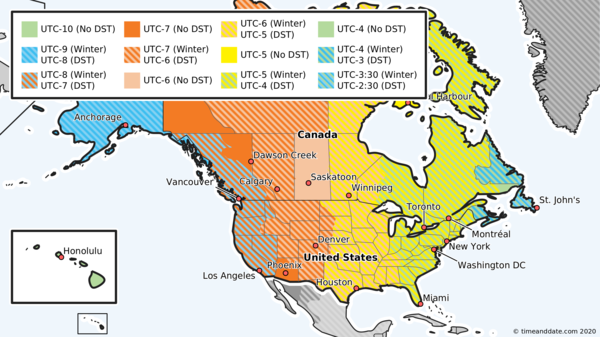DST Start 2021: US and Canada
Most of the United States and Canada start Daylight Saving Time (DST) on Sunday, March 14, 2021. Several states are passing bills for permanent DST.


The striped areas will start Daylight Saving Time on March 14, 2021.
Β©³ΩΎ±³Ύ±π²Ή²Τ»ε»ε²Ή³Ω±π.³¦΄Η³Ύ
People in areas that observe DST will set their clocks forward one hour from 02:00 (2 am) to 03:00 (3 am), local time, on March 14, 2021.
Standard time, also known as winter time, will resume on Sunday, November 7, 2021.
Most of Europe starts DST two weeks later on March 28, 2021.
Affects Most of the US
Only the following areas do not change their clocks:
- Hawaii and most of Arizona.
- The US dependencies American Samoa, Guam, Puerto Rico, the Northern Marina Islands, the US Minor Outlying Islands, and the US Virgin Islands.
Canada: DST Change
In Canada, clocks will change in almost all areas, except:
- Most of Saskatchewan
- Yukon
- Some locations in QuΓ©bec east of 63Β° west longitude (e.g., Blanc-Sablon)
- Southampton Island
- Some areas in British Columbia
Up to US Congress to Change DST Law
13 US states in favor of year-round DST. However, none have received congressional approval to abolish the time change. For this to happen, Congress first has to pass a federal law allowing states to observe DST year-round because today's law only allows states to forgo DST.
Legislation in 2020:
- In February, the Utah Senate voted to approve . The bill would have Utah spring ahead and stay ahead permanently, but it requires action by at least four western states before taking effect.
- In February, the Governor of South Carolina signed , intending to put the state on year-round DST.
- In March, Georgia adopted , urging the federal government to allow states to switch to permanent DST.
- In March, the Idaho Governor signed , which would make DST permanent in the state.
- In March, the Wyoming Governor signed , which would establish DST as the official time year-round if at least four neighboring states do the same.
- In June, the Governor of Louisiana signed to adopt Daylight Saving Time as the standard time.
Legislation in 2019:
- In December, the Governor of Delaware signed to keep the state permanently on DST. The bill requires that Pennsylvania, New Jersey, and Maryland each do the same.
- In June, Maine also passed into law to permanently keep the state on DST.
- The Governor of Oregon signed for permanent DST in June 2019. However, the bill stipulates that the law will only be implemented if Washington and California approve their all-year DST policies.
- In May, the governor of Washington signed in favor of permanent DST.
- In May, Tennessee governor Bill Lee signed , establishing DST as standard time.
- In December, Arkansas adopted βto express the will of Arkansas to adjust Arkansas's time to preserve sunshine.β
Legislation in 2018
- Florida's 2018 bill for permanent DST, dubbed the is awaiting congressional approval.
Canadians Are Ditching the Switch
Some Canadian provinces and territories are also ditching the switch in favor of permanent DST:
- On November 1, 2020, Yukon did not set their clocks back but stayed permanently on DST and now observes UTC -7 all year.
- Ontario passed in November 2020. The bill puts Ontario on permanent DST as long as Quebec and New York do the same.
In 2019, of British Columbians answered in favor of keeping the province on permanent DST. However, Premier John Horgan has said he will wait to see whether neighboring Washington, Oregon, and California go ahead with their proposals to scrap DST.
- The provincial government in Alberta has also and is considering scrapping DST. , 9 out of 10 said they wanted to stop changing clocks twice a year.
DST might become history in the European Union
Mexico DST Divided
A few northern Mexican border towns, such as Tijuana and ΄³³άΓ‘°ω±π³ϊ (Ciudad ΄³³άΓ‘°ω±π³ϊ), start DST on March 14, along with the US and Canada.
However, most of Mexico starts DST on Sunday, April 4, 2021. Some regions of Mexico, including cities like Hermosillo and °δ²Ή²Τ³¦ΓΊ²Τ, do not observe DST at all.
Other areas starting DST on March 14 are Cuba, Bermuda, the Bahamas, Saint Pierre and Miquelon, and Thule Air Base in Greenland.
Set Clocks Back or Ahead?
Daylight Saving Time (DST) shifts the local sunrise and sunset ΒιΆΉΣ³» forward one hour, resulting in more daylight in the evenings. To remember which way to set your watch, keep in mind one of these sayings: βspring forward, fall backβ or βspring ahead, fall behind.β The clocks spring ahead (= losing one hour) in the spring when DST starts and fall behind one hour (= gaining one hour) when DST ends in the fall.